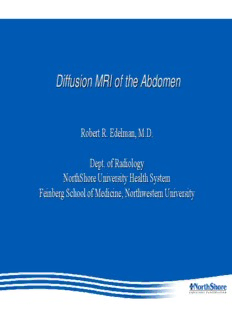
Diffusion MRI of the Abdomen PDF
Preview Diffusion MRI of the Abdomen
DDiiffffuussiioonn MMRRII ooff tthhee AAbbddoommeenn RRoobbeerrtt RR.. EEddeellmmaann,, MM..DD.. DDeepptt.. ooff RRaaddiioollooggyy NNoorrtthhSShhoorree UUnniivveerrssiittyy HHeeaalltthh SSyysstteemm FFeeiinnbbeerrgg SScchhooooll ooff MMeeddiicciinnee,, NNoorrtthhwweesstteerrnn UUnniivveerrssiittyy Diffusion Imaging • Random motion of molecules • Scale of motion is microscopic 0.1mm • Requires application of strong gradients to detect • Quantified as “ADC” (apparent diffusion coefficient) Diffusion MRI of Abdomen • Theory is that malignant lesions (but not benign ones) have restricted diffusion • Typically use mono-directional diffusion gradient with b value of 0 or 50 and ~500 and 1000 • Calculate apparent diffusion coefficient (ADC) map from images with two or more different b values • Diffusion MRI only increases exam duration by a few seconds (breath-hold) to a few minutes (respiratory-gated) Diffusion MRI of Abdomen Technical Considerations Kim SY et al. Radiology 2010; 255:815 Diffusion MRI of Abdomen How Reproducible are ADC Measurements? • Study of 49 malignant liver lesions (43 HCC, 3 colon Ca mets, 3 cholangioCa) at 1.5T • When ADCs of malignant hepatic tumors are used for monitoring treatment response, changes in ADC of approximately 30% or greater should be considered to be beyond the range of measurement error. • ADCs of respiratory-triggered DWI were higher than breath-hold DWI (possibly due to effect of respiratory motion with respiratory triggering) • Reproducibility of measurements affected by location and size of lesion (e.g. poor reproducibility for left lobe lesions) Kim SY et al. Radiology 2010; 255:815 Diffusion MRI of Abdomen Does It Improve Lesion Detection? • 211 focal liver lesions (136 malignant, 75 benign) • Overall detection rate was significantly higher for DWI (87.7%) versus T2-weighted (70.1%) imaging, particularly for small malignant lesions (1-3cm) and small (50) b value • FLL characterization was not significantly different between DW (89.1%) and T2-weighted (86.8%) imaging. • ADCs of malignant FLLs (1.39x10-3 mm2/sec) were significantly lower than those of benign FLLs (2.19x10-3 mm2/sec) • Respiratory-triggering better than breath-holding • No difference in DWI lesion detection for right vs. left lobes, but T2w worse in left lobe Parikh T et al. Radiology 2008; 246:812 Diffusion MRI of Abdomen Does It Improve Lesion Detection? treated breast Ca met cyst b=0 sec/mm2 b=500 sec/mm2 ADC map Parikh T et al. Radiology 2008; 246:812 Diffusion MRI of Abdomen Does It Improve Lesion Detection? colon Ca met T2w b=0 b=50 b=500 Parikh T et al. Radiology 2008; 246:812 Diffusion MRI of Abdomen What is Specificity for Distinguishing Malignant from Benign Lesions? • 43/55 lesions with restricted diffusion were malignant • 12/55 with restricted diffusion were benign: liver hemangioma, liver adenoma, autoimmune pancreatitis, pancreatic teratoma, abscess, inflammatory bowel wall thickening due to Crohn’s disease, Bartholin cyst, hemorrhagic ovarian cyst, and renal Rosai-Dorfman disease Feuerlein S et al. AJR 2009; 193:1070 Study of DWI at Northwestern Memorial Hospital • 577 lesions in 380 patients (from September 2005-July 2007) • Variety of lesions – 166 Hemangiomas, 147 Hepatomas, 107 Metastases, 95 Cysts, 43 FNH, 10 Abscesses, 9 Adenomas Courtesy Dr. Frank Miller
Description: